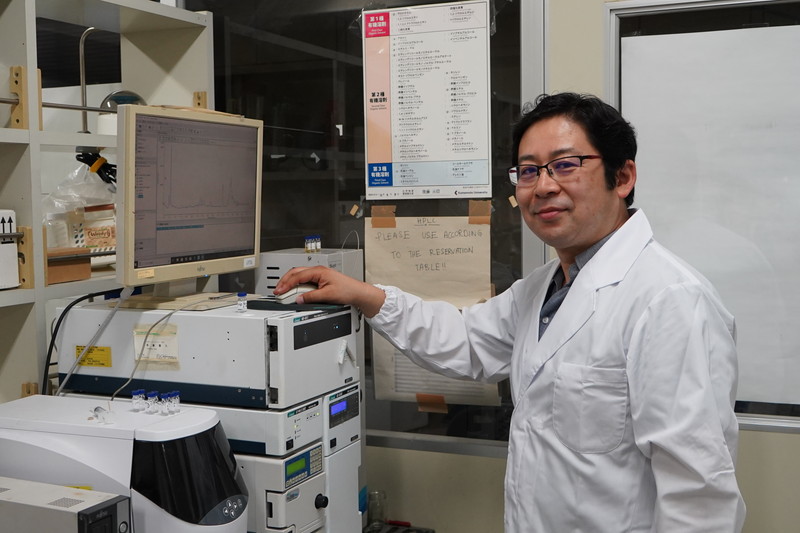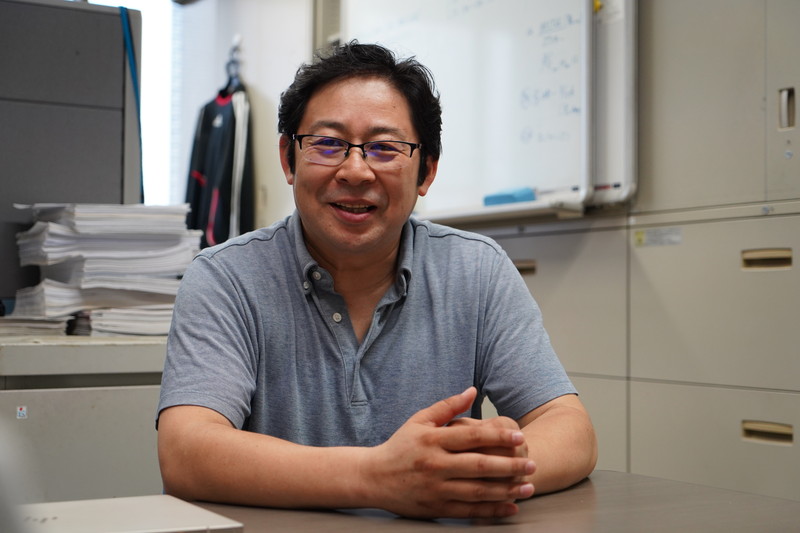NEWS
IROAST Researchers - Assoc. Prof. Mitsuru Sasaki
English Japanese
Reducing food loss while helping to decrease the environmental burden, revitalize the economy, and promote health and longevity

Assoc. Prof. Mitsuru Sasaki
IROAST International Joint Research Faculty Member
Institute of Industrial Nanomaterials
The widening acceptance of the SDGs (Sustainable Development Goals) demonstrates an increased interest in environmental problems and reduction of food loss in recent years. Associate Professor Mitsuru Sasaki is conducting research not only on reusing resources, but also on the effective use of resources to minimize the environmental burden and spur economic revitalization.
■ Environmentally-friendly technology to extract usable components from discarded items
Q: Please tell us about your research.
Sasaki: The basis of my research is converting items considered garbage or items that are discarded without being used into profitable substances or materials, with the aim of revitalizing the economy. Items considered garbage include food processing residue (leftovers), biomass, rice straw, and degraded seaweed produced from agriculture and fishery sites. These are sometimes reused to make fertilizer and other products, but I wondered whether this garbage could be converted into items that would lead to greater profit for people engaged in the agriculture, forestry, and fishing industries. I am currently undertaking joint research with a number of companies with this goal in mind.
One area of research is making new vinegar using sake lees and rice bran, which are produced in vast quantities in the process of making vinegar. I wondered whether it would be possible to produce new vinegar by processing sake lees and rice bran, which are conventionally processed as industrial waste, in high-temperature water to convert the proteins and polysaccharides in this material into water-soluble substances such as oligosaccharides and oligopeptides, and then re-adding these into the vinegar production process. We are currently conducting experiments on acetic acid fermentation of liquids containing large quantities of amino acids produced by converting the components of sake lees and rice bran, and we have successfully brewed vinegar that is comparable to commercially available black vinegar. However, there are still issues such as the intensely bitter taste of the vinegar, so it is not ready for sale just yet.
Q: What was your motivation for starting this research?
Sasaki: When I was a graduate student, I started researching how to dissolve water-insoluble cellulose in water. Some of the chemicals used to dissolve the cellulose would cause environmental destruction. I thought it would be revolutionary to be able to dissolve cellulose in water alone, so I experimented using special machines and trying different temperatures and pressures.
[A1]I replaced the originally translated “it” into “cellulose” to indicate clearly what is being referred to here. Please check if the change is accurate.
I am now conducting research using carbon dioxide to dissolve and extract usable components from bark and other parts of plants. I wondered if it would be possible to extract usable components that can be used as supplemental raw material to create products that are good for both the environment and health using only environmentally-friendly substances like water and carbon dioxide, and launch this technology on an industrial platform.

■ Forging alliances with overseas partners leads to achievements and opportunities not available in Japan
Q: What is the appeal of IROAST?
Sasaki: I am currently an IROAST International Joint Research Faculty Member and an associate professor at the Institute of Industrial Nanomaterials. The Institute of Industrial Nanomaterials focuses on research on 2D (two-dimensional) sheet-like materials, so receiving support from IROAST for research topics in areas other than 2D research is very appealing.
I have been supported by the IROAST Young Research Unit for two years since 2020. This unit normally conducts joint research with researchers from France and South Korea, but researchers from Mexico and Canada have also joined the project, and we have been able to exchange ideas online as well as compare data. Overseas travel has been impossible these last two years due to the COVID-19 pandemic, but with overseas travel now starting to open up again, I would like to strengthen our international network by conducting experiments abroad.
Q: There are many joint research projects within the Kumamoto University. What are the advantages of international joint research?
Sasaki: When considering just “biomass,” its aroma and strength differ depending on the cultivation environment, even with the same variety of plant. If we try to conduct experiments in Japan using material produced in France, the properties of the material change during transportation. When handling such material, sharing techniques and conducting experiments abroad help obtain data that are unavailable in Japan. Exchanging varied information with overseas researchers can lead to new research, and also results in the global spread of technology.

■ It is good to try researching topics you’re not normally interested in. IROAST provides opportunities for this kind of research.
Q: How do you spend your free time?
Sasaki: Thanks to my wife, I now love fishing. We go to Amakusa in the evening over the weekend to enjoy evening and early morning fishing. I haven’t caught much lately (laughs), but when I do manage to catch some fish, I take them home and we have them as sashimi. We also enjoy walking around and eating at Italian restaurants and sweets shops my wife finds on Instagram.
Q: What is your message to young researchers?
Sasaki: I didn’t have any clear goals when I was a student. But during my research on dissolving cellulose in my master’s course, I became interested in how cellulose changes its macromolecular structure, so I progressed onto a doctoral program, which led me to where I am today. Therefore, even if something does not seem interesting at first, it may become interesting after investigation, and other people who find it interesting will start to appear. We await your arrival with interesting research.
Reference Links
- IROAST Staff - International Joint Research Faculty Member
- Sasaki Lab.

